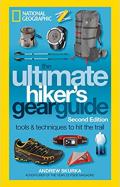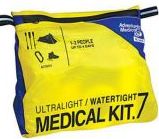| Day Hiker Gear List |
Proper planning and preparation is necessary anytime you venture into the great outdoors. A day hiker's gear list is a great way of helping you to prepare for your hike, while helping to make your trip safer and more enjoyable. Of course the hiking gear you'll need will vary according to the type of hiking you've planned: the length of your hike, the time of year, as well as the destination and the terrain you'll be traveling over.
Hikers should always be prepared for a wide range of temperatures and weather conditions while hiking in Grand Teton National Park. Temperatures in the mountains typically fluctuate as weather patterns change, especially at the higher elevations.
On average, the town of Moose, Wyoming receives more than 21 inches of precipitation each year, much of it falling as snow during the winter months. During the summer months daytime temperatures can reach well into the 80s; however, overnight lows throughout the park usually drop into the 30s. You should automatically expect temperatures to be at least 10 to 15 degrees cooler in the higher elevations at any given time of the year.
When hiking in the Tetons it's always a good idea to carry gear and clothing for a variety of weather conditions. It's also best to dress in layers, and carry rain gear in your backpack. Although not an exhaustive list, the following day hiker's gear list (and first aid kit) is a good starting point for ensuring that you'll have all the essentials before heading out on your next hiking adventure. You may want to add or remove items based on expected conditions and your personal needs. If you discover that you're missing any of the essentials, REI has all the necessary hiking apparel and gear you'll need to prepare you for any conditions.
| Essential Gear |
* Daypacks (REI Expert Advice: How to Choose Daypacks)
* Footwear (REI Expert Advice: How to Choose Hiking Boots)
* Extra socks (REI Expert Advice: How to Choose Socks)
* Base Layers (REI Expert Advice: How to Choose Base Layers)* Insulating Layer (REI Expert Advice: How to Choose Insulated Outerwear)
* Rain Gear (REI Expert Advice: How to Choose Rainwear)
* Wool or fleece hat
* Balaclava
* Gloves
* Water: full canteen(s), water bottle(s) or hydration pack
* Extra food: high energy snacks
* Compass (with the knowledge of how to use it)
* Emergency Space Blanket (smaller than a wallet)
* Waterproof matches / fire starter
* Flashlight or headlamp with new batteries
* Storm Whistle (in case you got lost)
* Small mirror (in case you got lost)
* A few yards of cord
* Watch
* First aid kit (see below)
* Personal medications
* Moleskin (for blisters)
* Body Glide (to prevent blisters)
* Insect repellent
* Sun protection (sunglasses, sunscreen, lip balm)
* Baseball style hat / Wide-brimmed hat (to protect from sun)
* A few zip-lock plastic bags
* Toilet paper (protected in a plastic bag)
* Money / ID
| Suggested / Optional Gear |
* Trekking poles (REI Expert Advice: How to Choose Trekking Poles)
* Cell phone (though may not have coverage in backcountry)
* Water Filter / Water purification tablets
* Camera (film / fully charged batteries)
* Binoculars
* Feminine products
* Gaiters
* Knee Support
* Notebook with pencil / pen
* Napkins
| Basic First Aid Kit |
Some examples of items for your First Aid kit are listed below. Customize your kit according to your personal needs. Be sure you're familiar with everything in your kit and remember to keep items up-to-date and replenished. It's also important to keep your first aid kit in a waterproof container. Finally, we strongly recommend that you take a First Aid class and a CPR class, and make sure that you keep current on these skills. (Adventure Medical Kits sells a variety of first aid kits specifically designed for hikers such as the one on the left)
* Personal medications
* Roll bandages
* Triangular bandages
* Ace bandages
* Butterfly bandages
* Sterile compresses
* Adhesive tape
* Sterile gauze pads
* Antiseptic wipes
* Miscellaneous band aids
* Twine
* Tweezers
* Safety pins
* Scissors
* Thermometer
* Latex gloves
* Tissues
* Plastic Bags
* Antibacterial soap / wipes
* Eye drops
* Burn ointment
* Sunburn lotion
* Disinfectant cream
* Decongestant and antihistamine tablets
* Anti-acids
* Antibiotic cream
* Aspirin / ibuprofen
* Hydrogen peroxide
* Diarrhea
medication
* Hydrocortisone cream
* Poison Ivy cream / cleansers
* Bee sting kit
* Snake bite kit
* Heat / cold packs
* Personal information / contact person
* First aid manual



